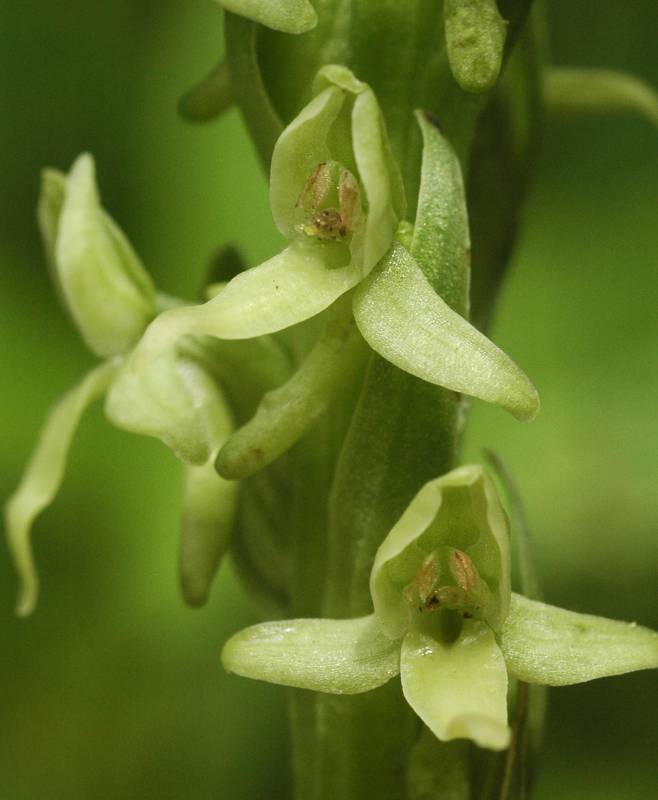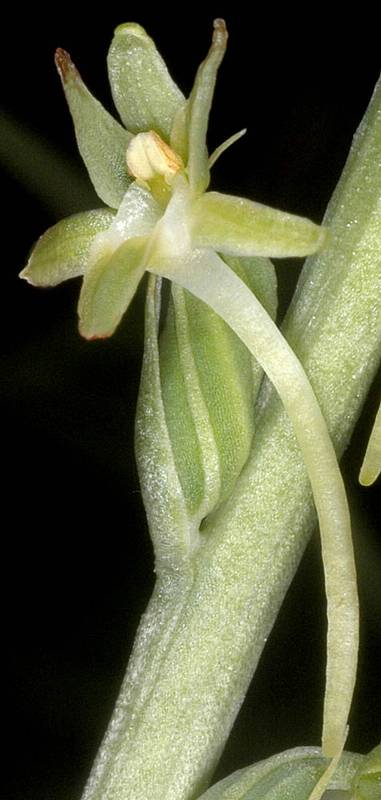Platanthera aquilonis
Platanthera elongata
eagle rein orchid, Sheviak's bog orchid
dense orchid, dense-flower rein orchid
Leaves few to several, becoming reduced to bracts towards inflorescence;
blade oblong to narrowly lanceolate, 2.7-23 cm long and 0.4-4 cm broad, somewhat folded lengthwise, base sheathing stem.
Leaves few, prostrate, ephemeral, basal;
blades sessile, lanceolate to oblanceolate, 7.5-32 cm long and 1-8.4 cm broad, barely folded along midvein;
cauline bracts linear-lanceolate.
Inflorescence a terminal spike, sparse to very dense;
flowers resupinate, light green to light yellowish green, with dull yellowish lip, or whitish green when conditions are cool;
lateral sepals spreading or bent strongly away from flower center;
petals rhombic-ovate to lance-falcate, margins entire;
labellum bent strongly downward, or extending forward, or apex adhered to apexes of dorsal sepal and petals, rhombic-lanceolate to lanceolate, not thickened basally, 2.5-6 cm long and 1-1.5 mm broad, base not rounded-dilated, margins entire;
spur thicker at apex than base or somewhat cylindric, 2-5 mm;
rostellum lobes diverging and directed downward, minute, rounded;
pollinaria 2, straight;
pollinia 2, turning forward, may be fragmenting, masses of pollen loose and free of anther sacs, trailing down onto stigma, stigma entire;
viscidia orbiculate, free;
ovary slender to stout, usually 5-13 mm.
Inflorescence a sparsely to densely flowered raceme, 6-70 cm;
rachis typically longer than peduncle;
bracts 3-23 mm;
flowers green, sometimes slightly translucent;
fragrance emits at night but lingers during day, faint, musky to honeylike;
sepals 2-6 mm long and 1-3 mm broad;
dorsal sepal ovate to oblong;
lateral sepals spreading to strongly curving outward, oblong-lanceolate to oblong;
petals erect-spreading or projecting, generally straight sided, unevenly ovate to narrowly lanceolate, 2-5.5 mm long and 0.6-2 mm broad, inner margins form a U shape;
labellum somewhat bent downward, widely ovate to narrowly elliptic, 2-5 mm long and 1-3 mm broad, apex commonly curving upward slightly;
spur horizontal to curving downward, 2-5.5 mm, approximately equal to labellum;
viscidia widely elliptic-ovate, 0.15-0.5 mm long and 0.1-0.3 mm broad;
rostellum blunt.
Capsules.
Capsules 3.5-10.5 mm;
seeds tan to cinnamon brown.
Platanthera aquilonis
Platanthera elongata
- Local floras:
BC,
OR,
WA
- Local Web sites:
Flora NW,
PNW Herbaria
WildflowerSearch
iNaturalist (observations)
USDA Plants Database
- LBJ Wildflower Center
- SEINet
- Plants of the World Online
- Encyclopedia of Life
- Wikipedia
- Google Image Search
- Local floras:
BC,
CA,
OR,
WA
- Local Web sites:
CalFlora,
CalPhotos,
Flora NW,
PNW Herbaria
WildflowerSearch
iNaturalist (observations)
USDA Plants Database
- LBJ Wildflower Center
- SEINet
- Plants of the World Online
- Encyclopedia of Life
- Wikipedia
- Google Image Search



